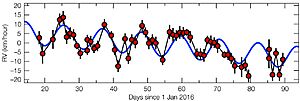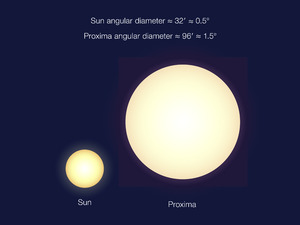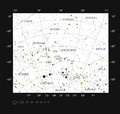Proxima Centauri b facts for kids
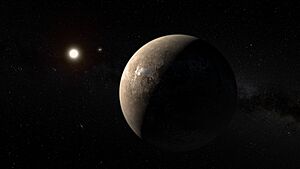
Artist's idea of Proxima Centauri b as a rocky planet, with Proxima Centauri and the Alpha Centauri system in the background. We don't know what the planet really looks like.
|
|
| Discovery | |
|---|---|
| Discovered by | Anglada-Escudé et al. |
| Discovery site | European Southern Observatory |
| Discovery date | 24 August 2016 |
|
Detection method
|
Doppler spectroscopy |
| Orbital characteristics | |
| 0.04856±0.00030 AU | |
| 11.1868+0.0029 −0.0031 d |
|
| 310 ± 50 | |
| Semi-amplitude | 1.24 ± 0.07 |
| Star | Proxima Centauri |
| Physical characteristics | |
|
Mean radius
|
0.94–1.4 R⊕ |
| Mass | ≥1.07±0.06 M⊕ |
| Temperature | Teq: 234 K (−39 °C; −38 °F) |
Proxima Centauri b (also called Proxima b) is an exoplanet. This means it's a planet outside our Solar System. It orbits a star called Proxima Centauri. This star is the closest one to our Sun. It's also part of a bigger group of stars called Alpha Centauri.
Proxima b is about 4.2 light-years (1.3 parsecs) away from Earth. You can find it in the Centaurus constellation. This makes Proxima b, along with Proxima d, one of the closest known exoplanets to us.
Proxima Centauri b circles its star quite closely. It's about 0.04856 AU (7.264 million km; 4.514 million mi) away. One full trip around its star takes about 11.2 Earth days. We don't know much else about it for sure. But scientists think it might be a rocky planet, similar to Earth. It has a minimum mass of at least 1.07 M⊕. Its size is only a little bigger than Earth's.
This planet is in the "habitable zone" of its star. This means it's not too hot and not too cold for liquid water to exist. But we don't know if it has an atmosphere. An atmosphere is important for life. Proxima Centauri is a "flare star." This means it sometimes shoots out strong bursts of energy. These bursts could strip away a planet's atmosphere. Because Proxima b is so close to Earth, it's a great target for future space missions.
Scientists announced the discovery of Proxima Centauri b on August 24, 2016. The European Southern Observatory (ESO) confirmed it. They used a method called "radial velocity." This method looks at how a star wobbles because of a planet's pull. Finding a planet in the habitable zone of our closest star was a huge discovery. It made people even more interested in the Alpha Centauri star system. Proxima Centauri b is now one of the most famous exoplanets.
Contents
How Proxima Centauri b Was Found
Scientists were looking for planets around Proxima Centauri even before Proxima b was found. Earlier studies in 2008 and 2009 didn't find any planets bigger than Earth in the habitable zone. Planets are very common around small stars called dwarf stars. On average, these stars have one or two planets each. About 20% to 40% of all red dwarf stars have a planet in their habitable zone. Red dwarfs are also the most common type of star in our galaxy.
Before 2016, telescopes at the European Southern Observatory in Chile noticed strange things happening with Proxima Centauri. These couldn't be fully explained by flares or star activity. This made scientists think a planet might be orbiting Proxima Centauri. In January 2016, a team started a project called "Pale Red Dot." Their goal was to confirm if this planet existed.
On August 24, 2016, the team, led by Anglada-Escudé, announced their discovery. They said a rocky planet in the habitable zone of Proxima Centauri could explain the strange observations. This planet was Proxima Centauri b. In 2022, another planet, Proxima Centauri d, was confirmed. It orbits even closer to the star. There was also talk of a third planet, Proxima Centauri c, in 2020. But its existence is still being debated.
What Proxima Centauri b Is Like
Distance and Orbit
Proxima Centauri b is the closest exoplanet to Earth. It is about 4.2 ly (1.3 parsecs) away. It takes about 11.186 Earth days for Proxima b to orbit Proxima Centauri. It orbits at a distance of about 0.049 AU. This is more than 20 times closer to Proxima Centauri than Earth is to the Sun.
As of 2021, we are not sure if its orbit is perfectly circular or slightly oval-shaped (called eccentricity). The planet's age is also unknown. Proxima Centauri itself might have been pulled into orbit around Alpha Centauri. So, it might not be the same age as Alpha Centauri, which is about 5 billion years old. It's also unlikely that Proxima Centauri b has any stable moons.
Size and What It's Made Of
As of 2022, the smallest possible mass for Proxima Centauri b is estimated to be at least 1.07±0.06 M⊕. This is just a minimum guess. We don't know the exact tilt of its orbit. This mass makes it similar to Earth. However, we don't know its exact size. Estimates for its radius range from 0.94 to 1.4 times the size of Earth. Its mass might be close to the line between Earth-like and Neptune-like planets.
Depending on what it's made of, Proxima Centauri b could be like Mercury. This would mean it has a very large core. Or it could be a planet with lots of water. Scientists can study the amounts of Fe, Si, and Mg in Proxima Centauri. This might help them guess what the planet is made of. These elements should be similar in the star and its planets.
We don't know much about Proxima Centauri b. Mostly just its distance from the star and how long it takes to orbit. But scientists have run many computer simulations. These models guess what the planet might be like. They consider things like its internal heat, how it spins, and how much water it might have.
Proxima Centauri b probably formed differently from Earth. It might have started with less water. It also likely had more impacts from space rocks. It probably didn't form at its current close distance to the star. There wouldn't have been enough material there. Instead, it likely formed farther away and then moved closer. Depending on its original material, it might have a lot of volatiles (materials that easily turn into gas).
Is It Tidally Locked?
Proxima Centauri b is probably tidally locked to its star. This means one side of the planet would always face Proxima Centauri. Like how our Moon always shows us the same side. If this is true, it's hard to say if life could exist there. One side would be super hot, and the other super cold. Only a small part of the planet might be livable.
However, the planet might not be tidally locked. If its orbit is more oval-shaped, it could spin differently. It might have a 3:2 spin-orbit resonance, like Mercury. This means it spins three times for every two orbits. Other planets around Proxima Centauri could also affect its spin. If the planet isn't perfectly round, it might not be tidally locked even with a nearly circular orbit. But a non-locked orbit would cause a lot of tidal heating inside the planet. This could lead to more volcanic activity. It might also stop the planet from having a magnetic field.
Proxima Centauri: The Host Star
Proxima b's star, Proxima Centauri, is a red dwarf. It gives off much less light than our Sun. It only radiates about 0.005% of the visible light our Sun does. It also gives off about 0.17% of the Sun's total energy. Even with this low energy, Proxima Centauri b is so close that it still gets about 70% of the infrared energy Earth gets from the Sun.
Proxima Centauri is also a flare star. This means its brightness can change a lot, sometimes 100 times brighter in just a few hours. Its average brightness is about 0.155±0.006 L☉.
Proxima Centauri has a mass of about 0.122 M☉. Its radius is about 0.154 R☉ of the Sun's. Its temperature is about 3,050±100 Kelvin. It is classified as an M5.5V star.
The magnetic field of Proxima Centauri is much stronger than the Sun's. It's about 600±150 G strong. It also changes in a seven-year cycle.
Proxima Centauri is the closest star to the Sun. That's why it's called "Proxima," which means "next to." It's about 4.2426 ± 0.0020 light-years (1.3008 ± 0.0006 pc) away. Proxima Centauri is part of a multiple star system. The other stars are Alpha Centauri A and Alpha Centauri B. These two form a binary star system. The way these stars move might have caused Proxima Centauri b to move closer to its star over time. Even though it's so close to Earth, Proxima Centauri is too faint to see without a telescope.
Conditions on Proxima Centauri b
Climate and Atmosphere
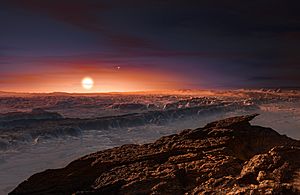
Proxima Centauri b is in the "habitable zone" of its star. It gets about 65% of the sunlight that Earth receives. Its average temperature is estimated to be about 234 K (−39 °C; −38 °F). Many things affect the climate of Proxima Centauri b if it has an atmosphere. These include its orbit, the type of light from Proxima Centauri, and how clouds behave.
Scientists think there are two main possibilities for Proxima Centauri b's atmosphere. One idea is that its water might have turned into ice. Then, hydrogen gas would have escaped into space. This would leave only oxygen or carbon dioxide in the atmosphere. Another idea is that it kept its original hydrogen atmosphere. Or it formed farther from the star, which would have helped it keep its water. If it has an atmosphere, it likely contains oxygen or carbon dioxide. If the planet also has a magnetic field, these gases could create auroras. We might even be able to see these auroras from Earth.
Scientists use Climate models, like those for Earth, to guess what Proxima Centauri b's atmosphere is like. Many things can happen depending on if it's tidally locked, how much water it has, and how much carbon dioxide is in its air. It could be:
- Covered partly or fully in ice.
- Have planet-wide oceans or small oceans.
- Be mostly dry land.
- Have areas with liquid water shaped like "eyeballs" or "lobster claws."
- Have an ocean hidden under a thin layer of ice.
Other things that matter are:
- How heat moves around the planet.
- Where continents are, which helps control carbon dioxide levels.
- How ocean currents move heat.
- Changes in ocean saltiness.
- How fast the planet spins.
- Heat coming from inside the planet.
- How sea ice forms and melts.
Keeping an Atmosphere
Keeping an atmosphere is a big challenge for Proxima Centauri b to be livable:
- Strong UV radiation and X-rays from Proxima Centauri are a problem. Proxima Centauri b gets 10 to 60 times more of this radiation than Earth. This radiation can make a planet's atmosphere evaporate. Hydrogen gas, for example, absorbs this energy and heats up. Then it can escape the planet's gravity. This can remove water by splitting it into hydrogen and oxygen. The hydrogen then escapes, taking other elements like oxygen and nitrogen with it.
- Stellar winds and coronal mass ejections (huge bursts from the star) are an even bigger threat. The stellar wind hitting Proxima Centauri b could be 4 to 80 times stronger than what hits Earth. The pressure could be ten thousand times greater. Strong UV and X-rays could push the atmosphere higher. This would make it easier for stellar winds to blow it away.
- The stellar wind around Proxima Centauri b is likely much thicker than around Earth. This depends on the star's magnetic field. We don't know if Proxima Centauri b has its own magnetic field. If it doesn't, the stellar wind can go deep into the atmosphere. This would strip away parts of it.
- If the planet is tidally locked, its atmosphere could freeze and collapse on the cold night side. This is especially a risk for an atmosphere mostly made of carbon dioxide.
- When Proxima Centauri was young, its habitable zone was farther away. If Proxima Centauri b formed in its current orbit, it might have been too close to the star for water to exist for up to 180 million years. This could have caused a "runaway greenhouse effect." All the planet's water would have turned into steam. Then, UV radiation would have split the steam into hydrogen and oxygen. The hydrogen, and thus all the water, would have been lost. This is what scientists think happened to Venus.
- Big impacts from space rocks could also destroy atmospheres and boil away oceans.
- If Proxima Centauri b is covered in ice with an ocean underneath, it might have "cryovolcanic" activity. This is like volcanism but with icy materials. This could create a thin atmosphere.
Even if Proxima Centauri b lost its first atmosphere, volcanic activity could rebuild it. A second atmosphere would likely have carbon dioxide. This would make it more stable, especially if there's an ocean. Also, impacts from exocomets (comets from other star systems) could bring water to Proxima Centauri b.
Is There Life on Proxima Centauri b?
When scientists talk about "habitability" for exoplanets, they usually mean if liquid water can exist on the planet's surface. For life as we know it, liquid water and an atmosphere are needed. Life hidden deep underground, like in a subsurface ocean, would be hard to find from Earth. But it could be a model for life on a cold, ocean-covered Proxima Centauri b.
Challenges for Life
Whether life can exist around red dwarfs is a big question:
- The star's activity and the planet being tidally locked would make it hard for life to start.
- The UV light from Proxima Centauri is "redder" (cooler) than the Sun's. It might not harm living things as much. But strong stellar activity could destroy an ozone layer. This would let dangerous UV radiation reach the surface.
- If its orbit is very oval, the planet might sometimes leave the habitable zone.
- Oxygen or carbon monoxide could build up to toxic levels in the atmosphere. However, high oxygen levels might help complex life forms develop.
- If there are oceans, tides could flood and dry coastal areas. This might help chemical reactions needed for life. It could also help life develop daily rhythms. It would also mix oceans and spread nutrients.
On the other hand, red dwarfs like Proxima Centauri live much longer than the Sun. They can live for billions of years, even longer than the estimated age of the Universe. This gives life a very long time to develop. The light from Proxima Centauri isn't great for oxygen-producing photosynthesis. But it might be enough for other types of photosynthesis. One study in 2017 guessed that an ecosystem on Proxima Centauri b might be about 20% as productive as Earth's.
Looking at and Exploring Proxima Centauri b
As of 2021, we haven't taken a direct picture of Proxima Centauri b. It's too close to its star to see clearly. It's also unlikely to pass in front of Proxima Centauri from Earth's view. No surveys have found any evidence of such "transits." Scientists are listening for radio signals from the star system. The Breakthrough Listen project detected a signal called BLC1 in 2019. But later, they found it was probably from human activity.
Future large telescopes on Earth and in space could directly see Proxima Centauri b. These include the James Webb Space Telescope and the Nancy Grace Roman Space Telescope. But it would still be hard to separate the planet's light from its star's light. We might be able to see light reflected from an ocean. Or we might see patterns from gases in its atmosphere. Scientists are trying to figure out what Proxima Centauri b would look like if it had certain types of atmospheres.
Even the fastest spacecraft we've built would take a very long time to travel interstellar distances. For example, Voyager 2 would take about 75,000 years to reach Proxima Centauri. Some ideas for reaching Proxima Centauri b in a human lifetime include solar sails. These could travel at 20% the speed of light. But then, how would they slow down when they get there? And how would they avoid hitting tiny dust particles at such high speeds? The Breakthrough Starshot project aims to develop technology to reach Proxima Centauri in the 21st century.
What Proxima Centauri b Looks Like From There
From Proxima Centauri b, the binary stars Alpha Centauri would look much brighter than Venus does from Earth. They would be very bright in the sky. Our Sun would appear as a bright star in the constellation of Cassiopeia. It would be about as bright as the stars Achernar or Procyon look from Earth.
Images for kids
-
Looking towards the sky around Orion from Alpha Centauri. You can see Sirius near Betelgeuse, Procyon in Gemini, and the Sun between Perseus and Cassiopeia.
-
This map shows the southern constellation of Centaurus. The location of Proxima Centauri, the closest star to our Solar System, is marked. You need a small telescope to see it.
Videos
See also
- Alpha Centauri Bb – An exoplanet once thought to orbit Alpha Centauri B, but later found not to exist.
- Astrobiology – The study of life in the universe.
- Extremely large telescope – Very big telescopes used to study space.
- Exoplanet orbital and physical parameters – Details about how exoplanets move and what they are like.
- List of potentially habitable exoplanets – A list of planets that might be able to support life.


